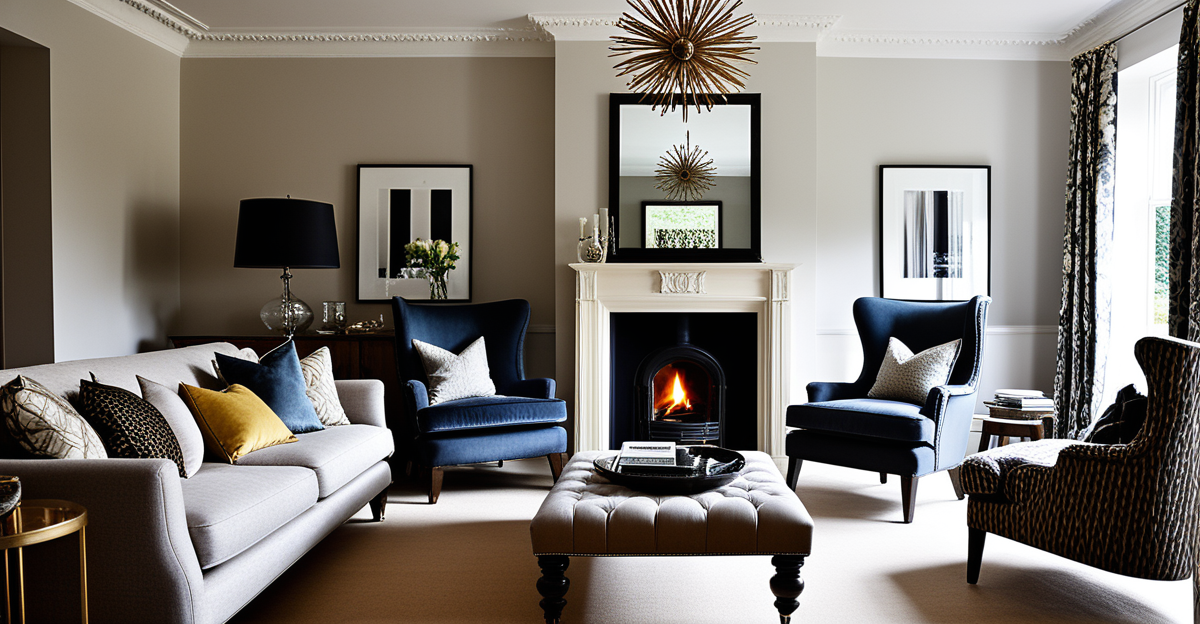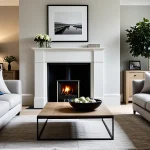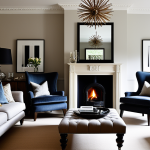Core Elements of British Interior Design
Understanding British interior design features begins with recognizing its signature colour palettes, materials, and textures. Traditional British decor often employs warm, muted tones such as deep reds, sage greens, and navy blues that evoke a sense of comfort and history. These colours harmonize with natural materials like rich wood, leather, and wool, creating a tactile and inviting atmosphere that reflects the essence of English heritage style.
Characteristic furniture in British interiors typically includes classic pieces like Chesterfield sofas, wingback chairs, and sturdy oak tables. These elements emphasize craftsmanship and timeless elegance, often paired with architectural details such as crown mouldings, panelled walls, and ornate fireplaces. Together, they establish an environment steeped in tradition yet adaptable to modern tastes.
This might interest you : How Can You Enhance Comfort and Style in Your UK Living Room?
Patterns and prints hold a significant role in British interior design features. Floral chintzes, tartan plaids, and intricate paisley designs bring vibrancy and storytelling into the space. These motifs appear on upholstery, curtains, and cushions, reinforcing the connection to English heritage style. Utilizing such prints strategically enhances the room’s depth without overwhelming the senses, balancing charm with refinement.
In summary, the core hallmarks—rich palettes, quality materials, substantial furniture, and thoughtful patterns—form the backbone of British interiors, encapsulating a style that celebrates history while remaining welcoming and livable.
In the same genre : How Can Incorporating Traditional British Decor Enhance Your Home’s Aesthetic?
Historical and Modern Influences in British Interiors
British interior design history reveals a rich tapestry of evolution, shaped by distinct periods that continue to influence modern British decor. Rooted in classical traditions, British interiors have transitioned through Georgian symmetry, Victorian opulence, and the handcrafted simplicity of the Arts and Crafts movement. Each era contributes unique elements that define the broader British interior design features seen today.
The Georgian period introduced balanced proportions and restrained elegance, favouring muted colour palettes and refined architectural details that laid a foundation for the English heritage style. Victorian interiors enriched this foundation with intricate ornamentation, darker hues, and luxurious fabrics, reflecting the era’s fascination with grandeur. In contrast, the Arts and Crafts movement emphasized artisanal quality and natural materials, advocating a return to craftsmanship that informs many contemporary British interiors.
Modern British decor blends these historical influences with innovative designs. Leading contemporary British designers reinterpret traditional motifs and materials, creating interiors that respect heritage while embracing current aesthetics. This fusion sustains the traditional British decor identity while allowing flexibility for evolving tastes and lifestyles. Understanding these historical layers is essential to appreciating the depth and versatility of British interior design features.
Practical Ways to Incorporate British Design at Home
Bringing British interior design features into your home starts with embracing the hallmark colour palettes that define traditional British decor. Opt for deep, muted shades like navy blue, sage green, or rich burgundy to anchor your rooms with authentic English heritage style. These colours work well on walls, upholstery, or accent pieces, establishing a warm and inviting atmosphere.
Textiles play a vital role in recreating British interiors. Incorporate familiar patterns such as tartan plaids, floral chintzes, or paisley prints through curtains, cushions, or throws. These traditional motifs instantly evoke the charm and storytelling that lie at the heart of British design features. Selecting fabrics with quality natural fibres like wool, linen, or velvet enhances the tactile and visual appeal, reflecting the craftsmanship prized in British decor.
Furniture choices should mirror the classic elegance found in British homes. Seek out pieces reminiscent of Chesterfield sofas or wingback chairs in leather or richly upholstered finishes. Oak tables or cabinets with sturdy, timeless lines complement these well. To enrich the space further, include architectural-inspired decorative accents such as crown mouldings or fireplace mantels if possible. Even smaller updates like British-style artwork, table lamps with patterned shades, or vintage accessories can infuse your home with the essence of English heritage style.
Small changes accumulate to create a cohesive British interior. By thoughtfully weaving colour schemes, patterns, and traditional furniture, you can confidently integrate British interior design features that celebrate history without sacrificing livability. This approach allows you to enjoy the depth and comfort that define traditional British decor directly in your daily living environment.
Core Elements of British Interior Design
British interior design features are best understood through their distinct colour palettes, materials, and textures that evoke a timeless appeal. The traditional British decor embraces warm, muted tones such as deep burgundy, olive green, and classic navy blue, which provide a rich but calming backdrop for living spaces. These colours blend harmoniously with the tactile qualities of natural materials like solid oak wood, smooth leather, and woven wool textiles, emphasizing quality and longevity typical of the English heritage style.
Characteristic furniture is essential to this aesthetic. Iconic pieces such as Chesterfield sofas and wingback chairs in leather or patterned upholstery are hallmarks of traditional British decor. They combine comfort with visual weight, creating inviting yet stately environments. Additionally, substantial oak tables or cabinets add a sturdy, handcrafted presence that reflects British interior design features’ roots in craftsmanship. Architectural details complement these furnishings, with crown mouldings, wood paneling, and decorative fireplaces contributing to the refined atmosphere that defines English heritage style.
Patterns and prints hold a special place in British interiors, bridging historical and contemporary interpretations. Classic motifs like tartan plaids, floral chintzes, and paisley prints appear in upholstery, curtains, and soft furnishings, bringing layers of texture and narrative. These patterns resonate deeply within traditional British decor as symbols of regional identity and artisanal tradition. Used thoughtfully, they enhance depth and character without overpowering a space, aligning with the subtle balance central to British interior design features.
Together, these elements—rich palettes, durable materials, signature furniture styles, and meaningful patterns—form the essential framework of British interiors. They convey a sense of heritage and comfort that remains relevant and adaptable, embodying the essence of the English heritage style.
Core Elements of British Interior Design
British interior design features revolve around a carefully curated combination of colour palettes, materials, and textures that express the essence of traditional British decor and the English heritage style. The hallmark colour schemes typically include deep, muted tones such as olive greens, rich burgundies, and classic navy blues. These shades create a warm, inviting backdrop that respects historic roots while offering versatility for modern living.
Materials play a pivotal role in defining this style. Natural, durable substances like solid oak, leather, and wool are frequently employed not only for their tactile richness but also for their longevity and association with fine craftsmanship. This emphasis on quality materials underpins the traditional British decor ethos, showcasing the English heritage style’s commitment to timelessness and substance.
Furniture selection is another critical British interior design feature. Iconic and substantial pieces like Chesterfield sofas and wingback chairs provide both comfort and a visual anchor within the space. These are often paired with sturdy oak tables or cabinets that reflect handcrafted construction. Architectural detailing complements the furniture and materials—think crown mouldings, decorative fireplaces, and panelled walls—which collectively contribute to a refined and layered environment.
Patterns and prints hold special significance, serving as an expressive yet controlled element of British interiors. Classic motifs such as tartan plaids, floral chintzes, and paisley prints appear frequently on upholstery, curtains, and cushions. These patterns are not decorative afterthoughts; they are deeply woven into the historical narrative of traditional British decor, often representing regional identities and artisanal heritage. When applied thoughtfully, these prints add dimension and warmth without detracting from the overall balance synonymous with English heritage style.
In essence, British interior design features combine considered colour choices, high-quality natural materials, signature furniture, and meaningful patterns to produce spaces that honour tradition while remaining inviting and adaptable for today’s homes. This integration of elements characterises the enduring appeal of the traditional British decor and distinctly embodies the English heritage style.
Core Elements of British Interior Design
Central to British interior design features are the distinctive colour palettes, materials, and textures that define the essence of traditional British decor and English heritage style. The colour schemes favor deep, muted tones—such as rich burgundy, olive green, and classic navy blue—which establish a warm yet sophisticated backdrop. These colours work cohesively to evoke a sense of comfort while honouring Britain’s design legacy.
Materials underpin the tactile and visual richness of British interiors. Durable and natural elements like solid oak, high-quality leather, and woven wool not only provide authenticity but also embody the craftsmanship central to British tradition. These materials, celebrated for their longevity and texture, elevate interiors by combining practicality with timeless elegance.
Furniture is a defining pillar of this style. Iconic pieces such as the Chesterfield sofa and wingback chair are quintessential components of traditional British decor. Their substantial form and refined upholstery merge comfort with stateliness. Complementing these are handcrafted oak tables and cabinets, which highlight the artisanal roots of British design. Architectural details—including crown mouldings, panelled walls, and ornate fireplaces—frame these furnishings, enhancing the layered, textured environment characteristic of the English heritage style.
Patterns and prints contribute significantly to British interiors, adding depth and narrative. Classic motifs like tartan plaids, floral chintzes, and paisley appear prominently in upholstery, curtains, and cushions. These patterns are not merely decorative—they represent regional identities and artisanal heritage deeply woven into British tradition. Employed thoughtfully, they enrich spaces with warmth and personality without sacrificing balance or subtlety.
In summary, the core elements of British interior design—carefully selected colour palettes, quality natural materials, classic furniture styles, and meaningful patterns—combine to create interiors that are both historically grounded and welcoming. This seamless integration upholds the distinctiveness of traditional British decor and the enduring appeal of the English heritage style.






